|
 Amanita phalloides Amanita phalloides
SynonymsAgaricus phalloides
Amanita mappa
Amanita citrina
BiostatusPresent in region - Exotic
Images (click to enlarge)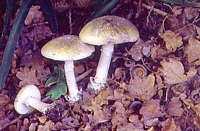
Caption: Death Cap. Under oak
Owner: P. Buchanan | 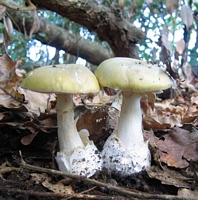
Owner: B. Dee | 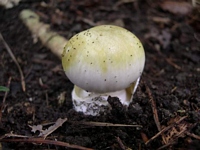
Owner: B. Dee | 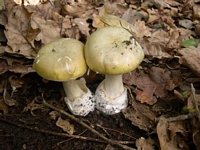
Owner: B. Dee | 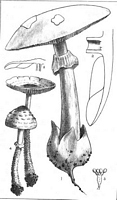
Caption: Fig. 1. Amanita phalloides, Fries; natural size. Fig. 2. Section through portion of pileus and
stem of same; natural size. Fig. 3. Basidium and spores of same ; x 400. | 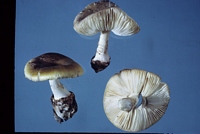
Owner: Herb. PDD | 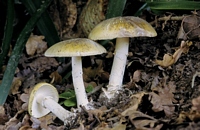
Owner: Peter Buchanan | 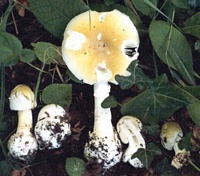
Owner: J.A. Cooper | |
Article: Ridley, G.S. (1991). The New Zealand species of Amanita (Fungi: Agaricales). Australian Systematic Botany 4(2): 325-354.
Description: Baisidlocarps small to medium, solitary to gregarious. Pileus to 85 mm wide, margin entire, 'sulfur-yellow' with a 'greenish' tinge, and 'brown' radiating fibrils, or 'greyish' with 'brown' tints, paling at edge, with faint radial markings, silky smooth, without volva remnants. Lamellae crowded, free, 6-12 mm wide, white; lamellulae subtruncate. Stipe 70-80 mm high, 12-19 mm diameter, hollow, from clavate to bulbous base, occasionally pointed, 28-32 mm diameter, surface above the annulus faintly striate or pulverulent and white, below annulus sparsely floccose, white, with a free, white, fleshy volva limb, or an oppressed, membranous volva limb which tears irregularly. Annulus membranous, finely striate, margin finely serrulate, pendulous, white. Context of pileus white or slightly coloured under the disc, stipe white.
Spore print white. Basidiospores (20/2), 8-9(-10.5) x 6.5-8.5 µm, Qm 1.12, Q 1. 06-1. 30, subglobose to broadly ellipsoid, hyaline, amyloid. Basidia 34. 5-5 1. 5 x 10.5-13 µm, 1-4-spored, not clamped. Lamella margin cells numerous, 20-50 x 10.5-22.5 µm, mostly clavate, hyaline. Pileipellis up to 380 µm wide, non or only very slightly gelatinised. Volvo trama regular, hyphae to 15 am wide, and rarely, enlarged terminal cells.
Article: Massee, G.E. (1899) [1898]. The fungus flora of New Zealand. Transactions and Proceedings of the New Zealand Institute 31: 282–349 Wellington:.
Description: Pileus ovate, then campanulate, finally expanded, obtuse, covered with a pellicle that is viscid
when moist but not glutinous, rarely with one or more patches of the volva attached, margin
regular, even, colour very variable, usually white or pale-yellow when exposed to light,
greenish or with an olive tinge or often spotted when in the shade; flesh rather thick, white ;
7-11 cm. across; gills free, ventricose, 6-8 mm. broad, pure white; stem 8-12 cm. long, 1.5-2
cm. thick, almost glabrous, white bulbous, solid at the base, hollow and slightly narrowed
upwards, often curved; ring superior, large, reflexed, slightly striate, tumid, usually entire,
white; volva more or less buried in the ground, nearly free, lateral margin irregular; spores
subglobose, 7-8 µ diameter.
Habitat: In woods.
Distribution: Northern Island, New Zealand. Europe, Australia, United States.
Notes: Distinguished by the large nearly free volva and ample ring. Smell not strong, but unpleasant.
Very poisonous. The majority of cases of poisoning caused by Fungi in Europe are due to
partaking of this species for food. Amanita mappa, a species superficially much resembling A.
phalloides, is distinguished from the latter by the volva being adnate to the base of the stem,
except a narrow free entire margin. Poisonous.
Article: Massee, G.E. (1899) [1898]. The fungus flora of New Zealand. Transactions and Proceedings of the New Zealand Institute 31: 282–349 Wellington:.
Description: Pileus 6-10 cm. across, rather fleshy, convex, then almost plane, dry, pale-yellow, sometimes
whitish or with a tinge of green, with a few irregular patches of the volva adhering; gills
slightly adnexed, rather narrow, crowded, white; stem 5-8 cm. long, smooth, white, equal,
globosely bulbous at the base; ring superior, soft, usually more or less torn; volva splitting in
a circumscissile manner, connate with the base of the stem, free margin narrow; spores
subglobose, 7-9 µ. diameter.
Habitat: On the ground.
Distribution: North Island. Europe, North America.
Notes: Smell strong, colour variable. A very poisonous fungus. Allied to Amanita phalloides ;
differing in the shorter equal stem and narrow free margin of the volva.
Article: Horak, E. (1971). A contribution towards the revision of the Agaricales (Fungi) from New Zealand. New Zealand Journal of Botany 9(3): 403-462 (http://www.rsnz.org/publish/abstracts.php).
Notes: Apparently introduced with exotic trees such as Quercus or Picea.
|